

Yacht Installed on Docker – Portainer Alternative
In OpenMediaVault , Tutorials , Video by dbtech September 24, 2020
In this video we’re going to take a look at a Docker application called Yacht.
“Yacht is an alternative to Portainer that aims to make docker more accessible to the everyday person and is focused on selfhosters instead of the enterprise.” – SelfHostedPro
While Yacht operates very much like Portainer, I feel like the interface is more user-friendly and information is more easily available on Yacht than on Portainer.
About Yacht
Yacht’s home screen is a dashboard of all your running containers with information about the memory and CPU being used by each container in real time.
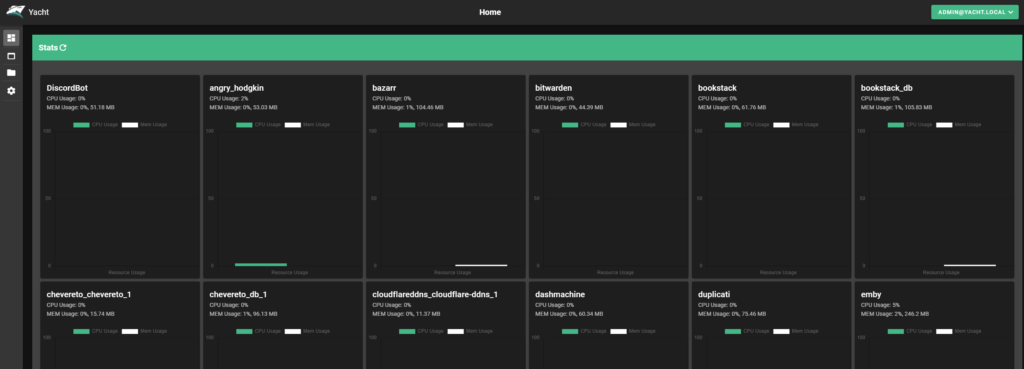
From there, you can click the title of any of the containers and get more information about it.

There are a couple of different ways to install applications. The first way to install an application is by clicking on the “New Application” button on the left side and then filling in each of the black fields for the 4 different steps.

Once you fill out each page, you can then click the “Continue” button and move to the next step. When you get to step 4, you can then deploy the container as you would in Portainer.
Another way is to use templates, again like in Portainer. I’m using the template that was shared on SelfHostedPro’s Yacht page as it’s a great starting point.
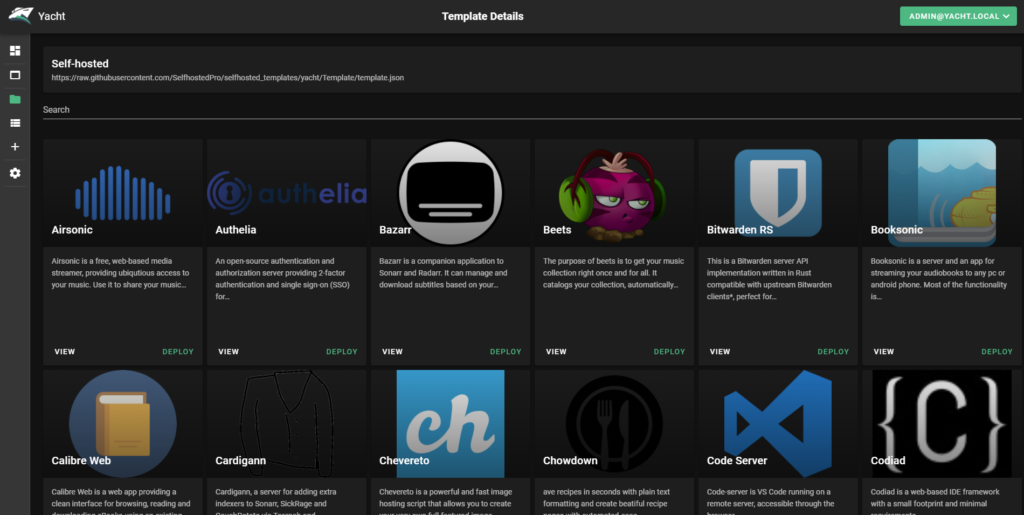
Click on the “Deploy” button under the application you’d like to install and you’ll be presented with a familiar screen, but this time, most of the data is already filled out!
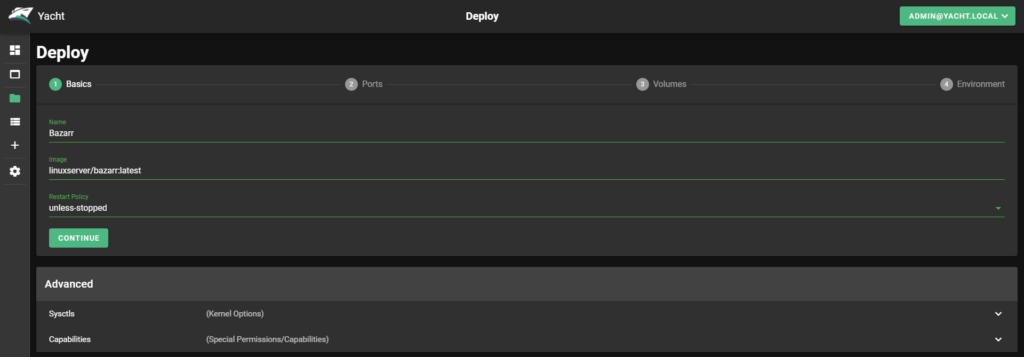
That’s the basic idea behind Yacht. Please keep in mind that this is still in early development so there may be bugs or things to report. Bugs can be reported via Github or Discord .
Installing Yacht
Installing Yacht is pretty simple as it only takes 2 SSH commands to install.
First, we’ll create a volume:
Then we’ll install the container:
You might need to change the 8000 port to something else if you already have Portainer installed on port 8000.
That’s all there is to installing Yacht. The login credentials are:
- [email protected]
This has been tested to work with x86 processors as well as Arm processors, so you should be able to install it on just about any hardware you have laying around.
Github: https://github.com/SelfhostedPro/Yacht
Discord: https://discord.gg/srRUF5S
OpenMediaVault Tutorials
If you’re interested in other tutorials for your home server, check here: https://dbtechreviews.com/category/openmediavault/
/=========================================/
Like what I do? Want to be generous and help support my channel?
Here are some ways to support:
Patreon: https://dbte.ch/patreon
Ko-fi: https://dbte.ch/kofi
Remember to leave a like on this video and subscribe if you want to see more!
Twitter: https://dbte.ch/tw
Facebook: https://dbte.ch/fb
Subscribe: https://dbte.ch/ytsub

A web interface for managing docker containers with an emphasis on templating to provide 1 click deployments. Think of it like a decentralized app store for servers that anyone can make packages for.
https://github.com/SelfhostedPro/Yacht Yacht Yacht is a container management UI with a fo...
Search Results

Did I break Pluralsight? and some personal updates.

Introducing Glaze, a tool to protect human artists from style mimicry by generative AI models

Demo: NVIDIA AI Enterprise with Red Hat OpenShift

AI, Ethics, and Transparency Part Deux

Nvidia GTC 2024 Round Up
Yacht – an open source, self hosted, modern, web gui for docker management.
- May 9, 2022
- Containers Open Source

Here’s an interesting new opensource project.
TIME STAMPS
- 00:00 Beginning
- 00:09 Introduction to Yacht
- 02:50 Thank you to all my Patrons over at Patreon
- 04:25 Install Yacht using Docker-Compose
- 08:00 Logging into Yacht UI for the first time
- 10:00 Change our Yacht Default Credentials
- 10:35 Yacht Dashboard and Container Details
- 13:05 Applications View
- 13:55 Check for New Versions of Containers
- 14:35 Container Detail – Top Tabs
- 15:20 Projects in Yacht – Adding Custom Docker Apps
- 17:05 Resources in Yacht
- 17:50 Settings in Yacht
- 19:15 Templates in Yacht for Pre-built Apps
#DataScientist, #DataEngineer, Blogger, Vlogger, Podcaster at http://DataDriven.tv . Back @Microsoft to help customers leverage #AI Opinions mine. #武當派 fan. I blog to help you become a better data scientist/ML engineer Opinions are mine. All mine.

Yacht vs. Portainer – Docker dashboard comparison
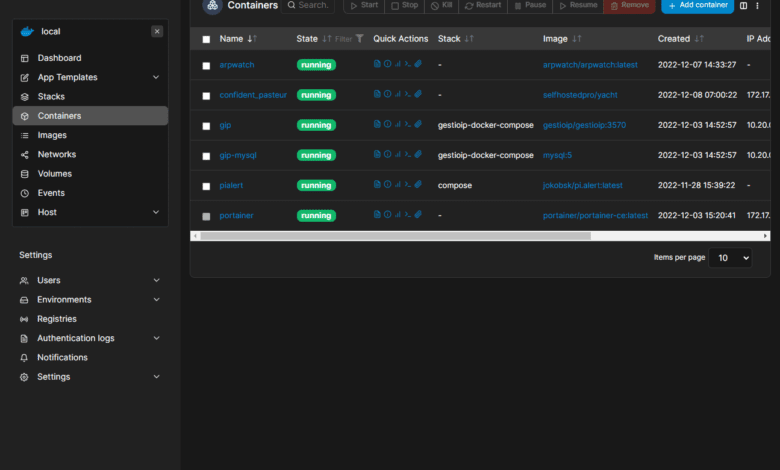
When you start working with Docker or containers in general, one of the first things you will probably want is some type of GUI to help with day-to-day workflows and operations for managing Docker containers and Docker apps with an easy-to-access web interface. There are a couple of solutions out there providing great Docker containers dashboard solutions, Yacht and Portainer. Let’s look at Yacht vs. Portainer and see what features and capabilities each offers.
Take a look at my video comparison of the two products here:
Why a Docker containers dashboard solution?
As you get into working with Docker containers, having a GUI tool to interact with your containers saves time and helps to visualize the Docker app’s infrastructure. Docker has a very robust command line interface, allowing you to do basically anything you need to do from the command line.
However, for newbies starting out and day-to-day management, the command line can be cumbersome for carrying out the required activities. A point-and-click interface to navigate your Docker infrastructure offers many advantages for managing Docker applications.
What is Yacht?
To begin, what is Yacht? Yacht is a web interface for managing Docker containers and focuses on templating. With templates, you can have one-click deployments of dockerized applications.
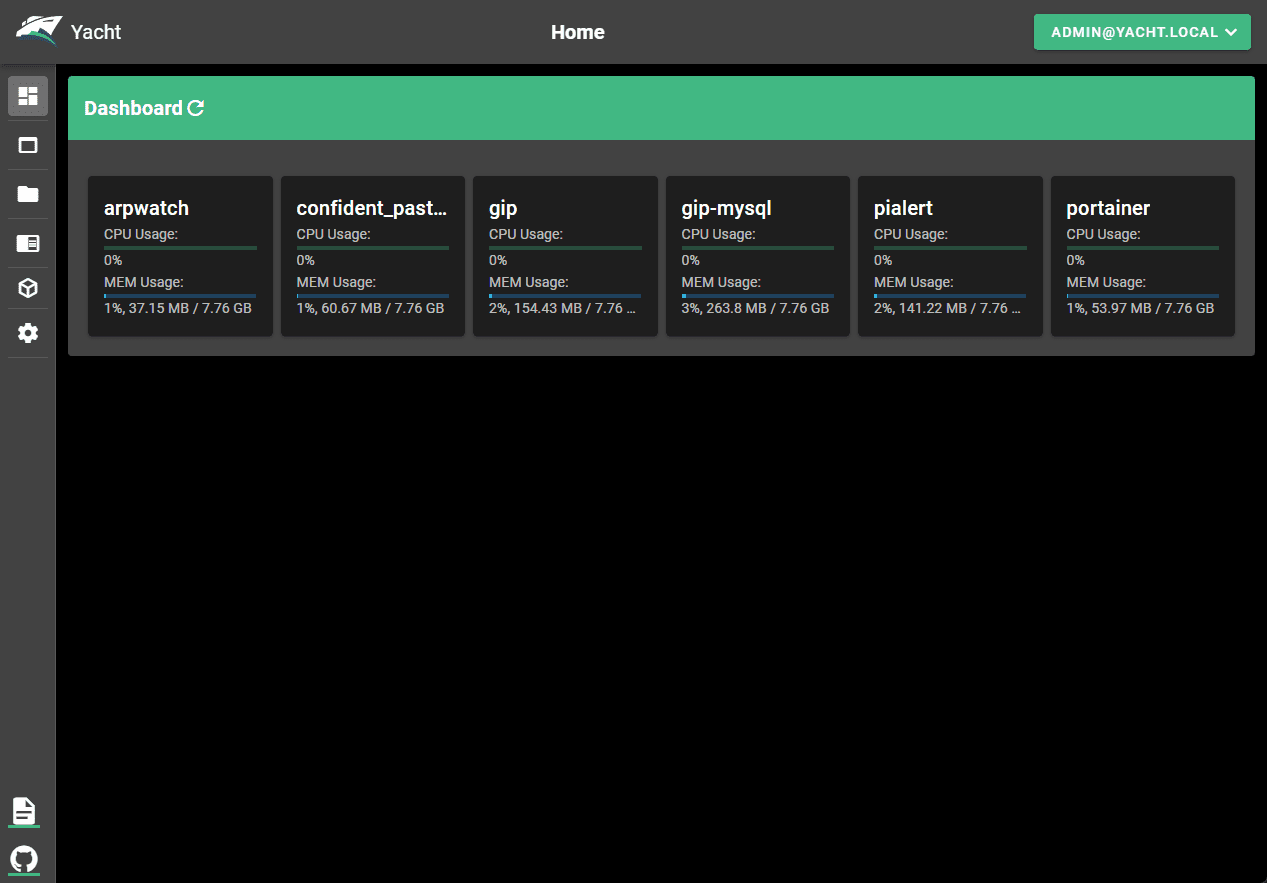
Yacht refers to this as a decentralized app store for servers for which you can make packages in your environment. It is considered to be a Portainer alternative and provides many of the same features in a yacht compare Portainer comparison.
Features of Yacht
Comparing Yacht vs. Portainer, Yacht provides many features for those wanting to manage their Docker apps and containers. Those include the following:
Templating functionality (Portainer compatible)
Container management (basic features)
Updating templates
Use template variables for one-click deployment
Container deployment wizard
Docker containers dashboard for seeing all containers in one place
Docker compose support and editor
One-click editing of containers and lifecycle management
Ability to view logs
Create Projects (Docker compose)
Nice menu driven interface from the left side
So, Yacht allows you to run multi-container applications with a GUI dashboard interface to interact with your containers from a simple website interface.
Compose Support
Yacht does include Docker compose support, using the built-in Projects included with Yacht. Using the Projects feature, you can enter a new Compose Template.
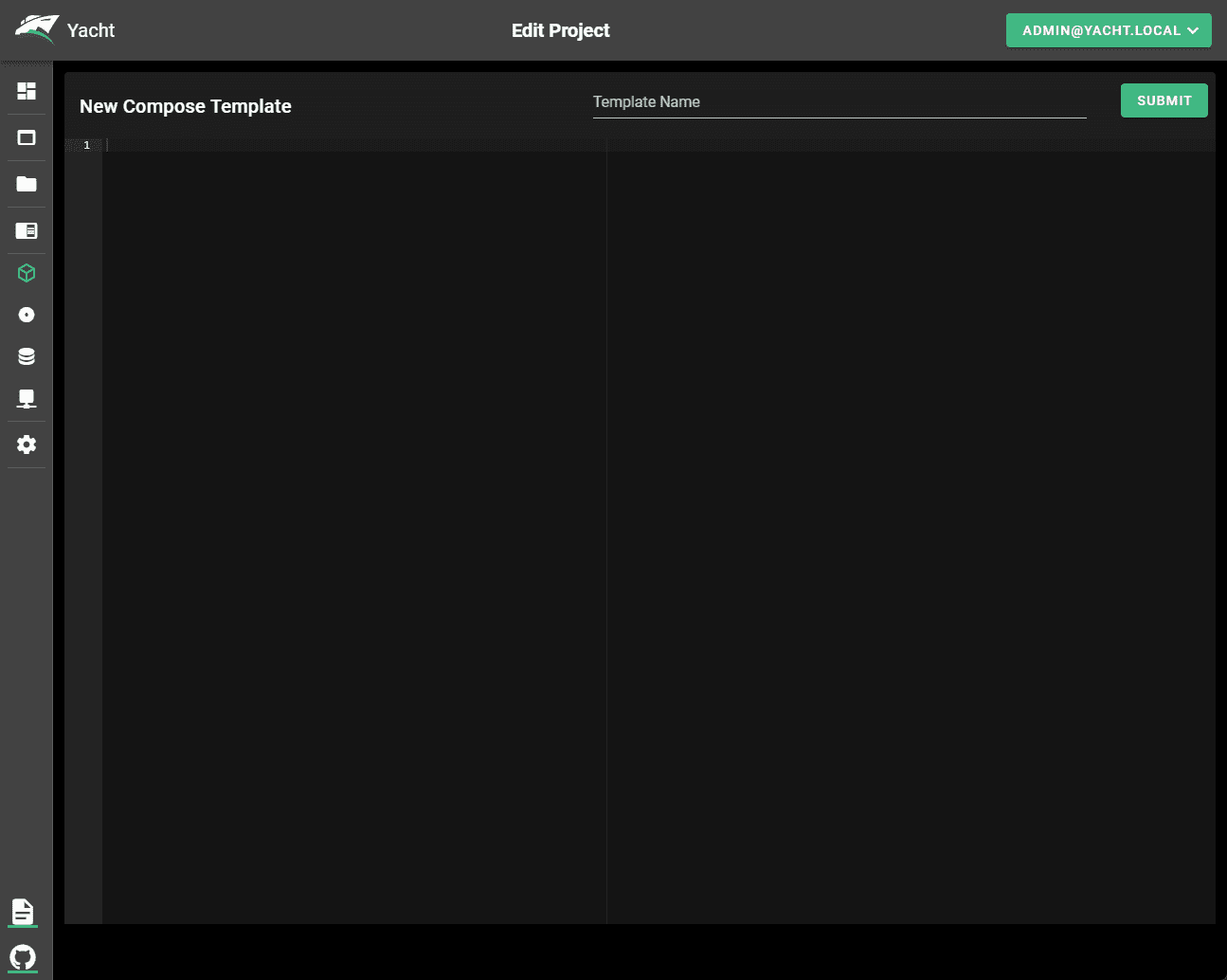
Missing features currently
A call out to a feature that I would like to see on a Yacht machine is the ability to access your containers CLI from the Yacht GUI. This is a feature that Yacht mentions are coming soon.
The features marked as “coming soon” currently include the following:
User Management
Container CLI attachment
Another feature in Yacht that isn’t quite as good as Portainer is the App
Podman support
One cool feature that I like with Yacht is it is compatible with Podman. You can perform the same installation with Podman as you can with Docker:
Yacht install
If you are not installing in a self-hosted Docker server , there are a few options for installing Yacht. These include Docker, OpenMediaVault, Docker Compose, or DockSTARTer. The process to install Yacht in a self-hosted environment is super simple.
Self-hosted Yacht install example
For a self-hosted Docker instance, you have two lines to enter to get up and running:
Many who want to try out Yacht may already be running Portainer. If that is the case, you will need to adjust the external port 8000 to 8001 or something else to run them side-by-side.
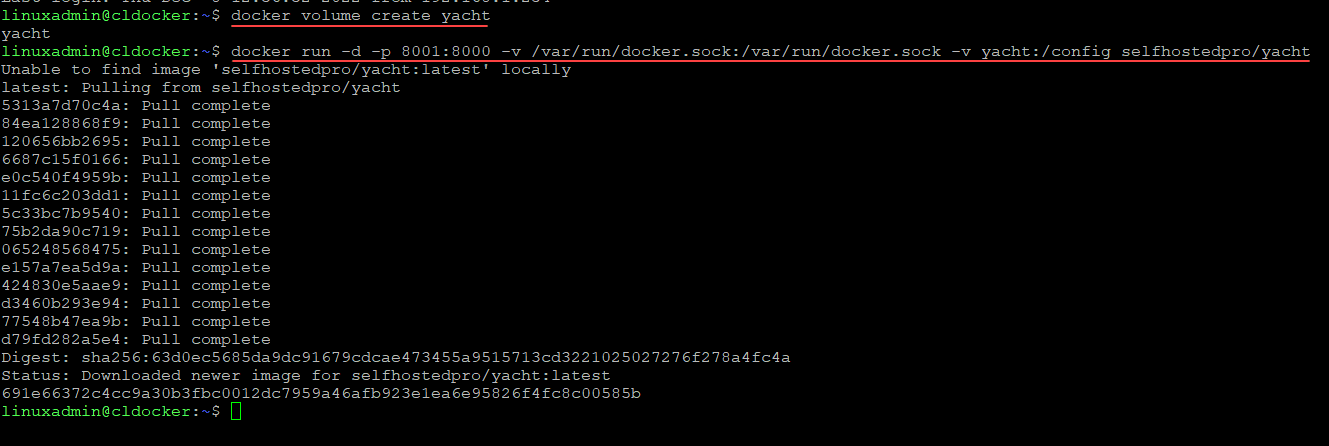
Log in with the [email protected] pass credentials.
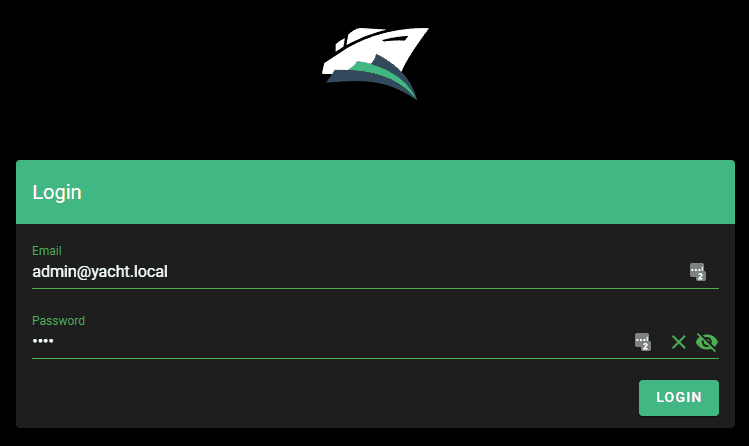
What is Portainer?
Portainer is a well-known container management platform providing a rich GUI interface to work with your containers, applications, templates, config maps, secrets, etc. It helps to reduce the complexity of container adoption and addresses security challenges.
Portainer works with more than Docker
Comparing Yacht vs. Portainer, Portainer is not only a tool that understands Docker apps, it also understands and works with Docker, Swarm, Nomad, and Kubernetes. Comparing Portainer to Yacht, it is a much more fully-featured tool that is also much more polished in its look and feel. It has been around longer and shows from a feature and useability standpoint.
Below is the overview dashboard of the Portainer connected to a Docker host.
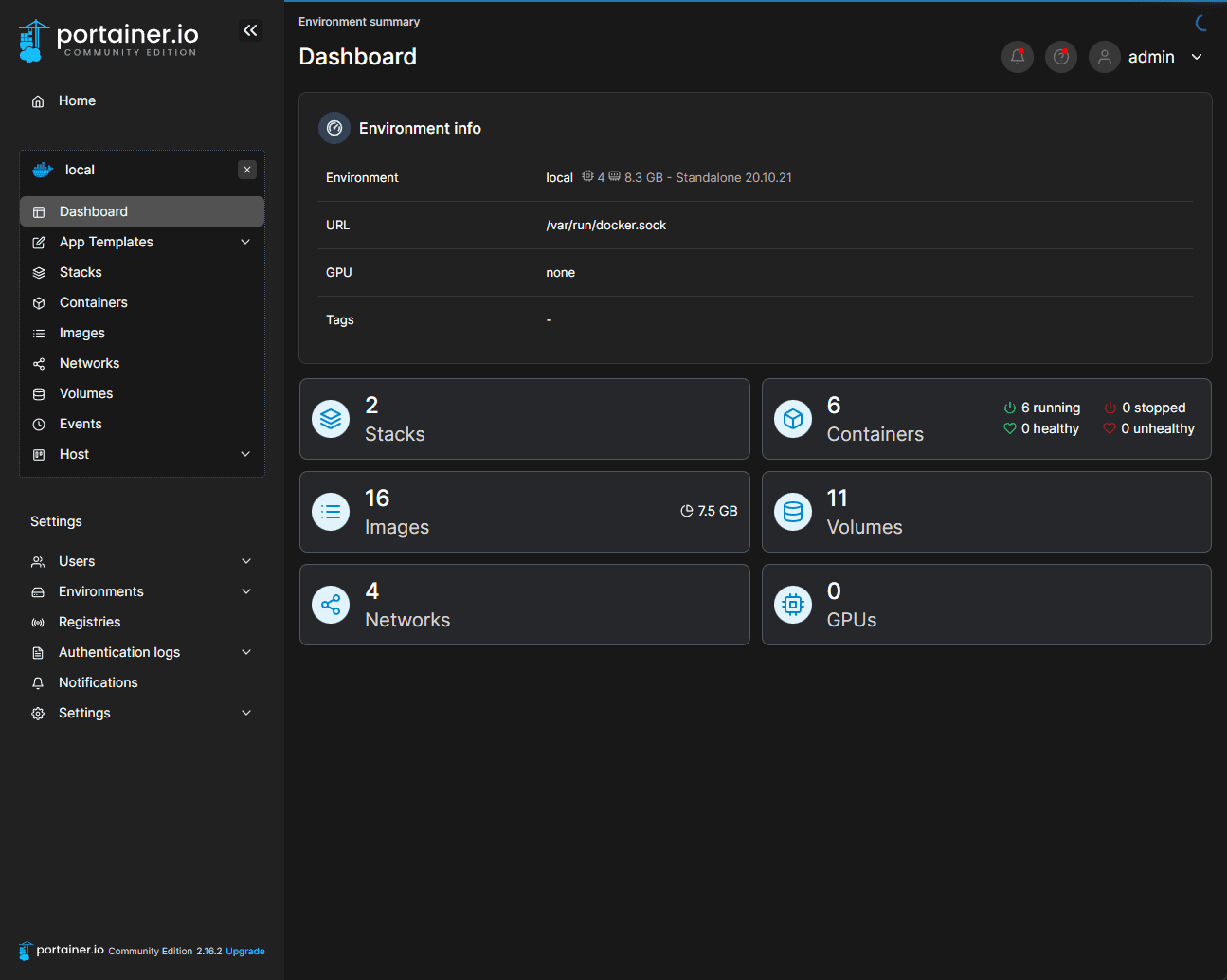
Looking at your list of running containers.
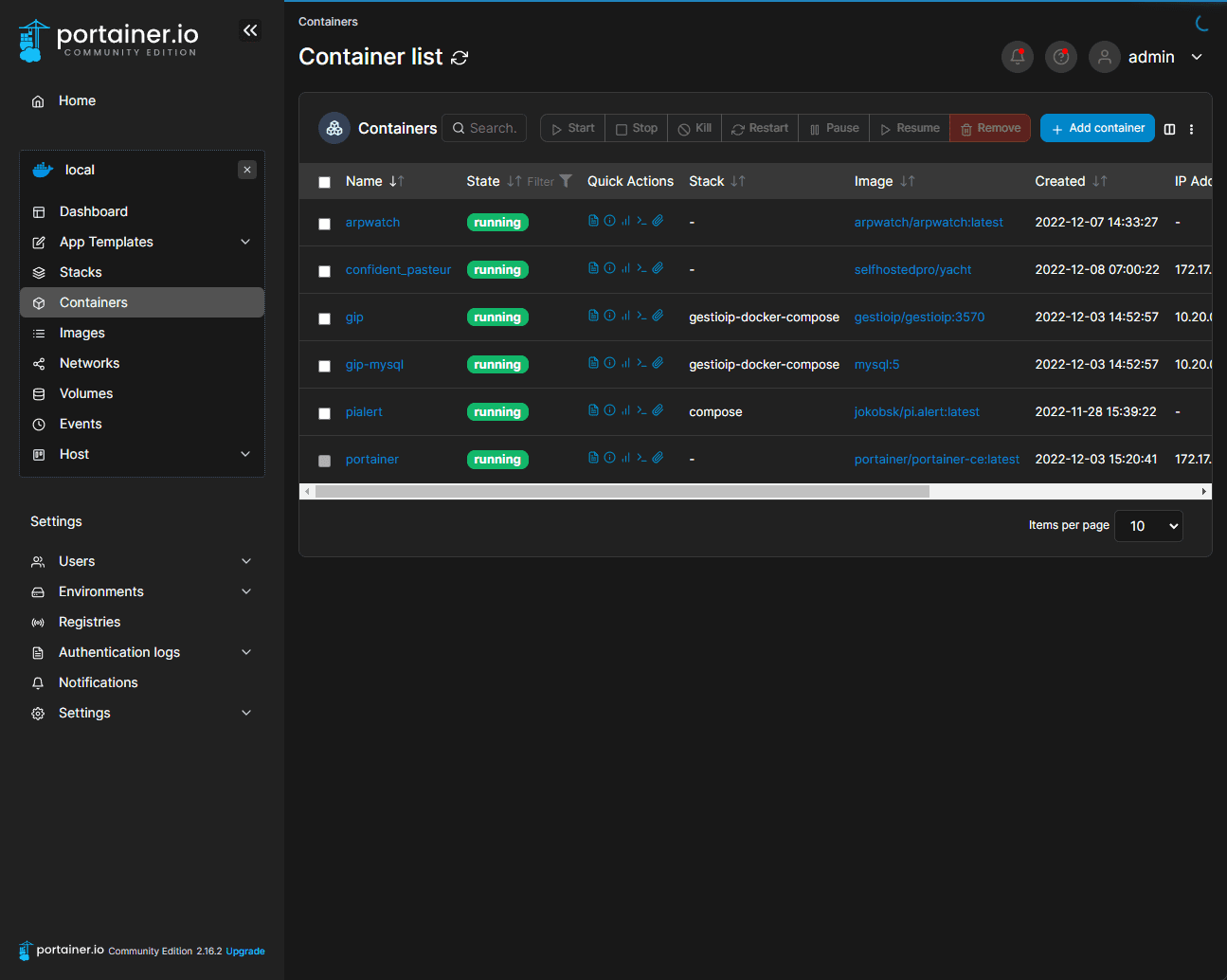
Portainer features
Portainer has many great features, including:
Overview dashboard
Image management
Built-in app templates
Visibility of Docker networking
Volumes, events, and host configuration
Ability to implement stacks using Docker Compose
Docker exec console – Managing Docker containers
Using the Docker exec console provides a great way to access the Docker CLI when needed from the Docker dashboard. As this is currently a feature missing from Yacht, Portainer is the tool of choice if this is a requirement. Honestly, it is a great feature to be able to expect to the console when needed directly from your Docker container dashboard.
Portainer install
The Portainer installation is very similar to Yacht. It is a couple of commands to get started with a self-hosted environment:
Portainer Community Edition vs. Business Edition
There are two versions of Portainer available – Community Edition and Business Edition. To note the difference between those two versions, Community Edition is free and open-source software. It is designed for individuals, home lab users, or very small environments that want to use Portainer.
Business Edition is commercially supported software. It includes features with Security, Access Management, Permissions, Auditing, and making ensuring you want to take Portainer into production.

Final Thoughts comparing Yacht vs. Portainer
Looking at Yacht vs. Portainer, both Yacht and Portainer are excellent free and open-source tools allowing you to manage and configure your Docker containers in a web interface using a modern GUI. Yacht is definitely the newer and less fully-featured tools of the two. I really like what I see with Yacht. However, it is missing some of the bells and whistles provided by Portainer, like exec CLI support from the interface.
Portainer also provides Kubernetes integration which does not appear to be supported by Yacht. Yacht has documented support for Podman, which isn’t shown with Portainer, although several blog posts cover how to install Portainer with Podman.
Check out Yacht here: Welcome To Yacht | Yacht
Check out Portainer here: Powerful container management software for Platform Teams, DevOps, Dev ( portainer.io )
Subscribe to VirtualizationHowto via Email 🔔
Enter your email address to subscribe to this blog and receive notifications of new posts by email.
Email Address
Brandon Lee
Related articles.
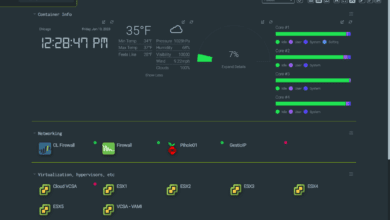
Best docker containers for Synology NAS

Best Docker Containers Commands You Need to Know
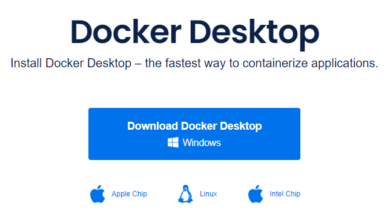
Docker Desktop Starting Forever Windows 11 or 10 Error
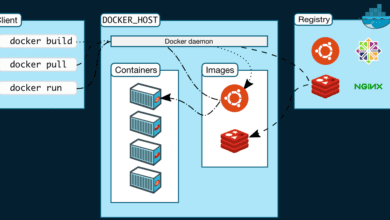
Best Docker Containers for Home Server
Leave a reply cancel reply.
Your email address will not be published. Required fields are marked *
Notify me of new posts by email.
This site uses Akismet to reduce spam. Learn how your comment data is processed .
- This Thread
- More Options
Docker, Portainer, Yacht and Cockpit how to Windows
- Jan 9th 2022
Howdy Folks,
so I've been following along since some time now, joined on StoneBurner, jumped Erasmus, still running Arrakis, as I run a bunch of VMs on the omv-Extra PHPVirtualBox plugin and I as the admin and owner was more or less out cold the past 30 months or so due to a bunch of health issues, end of 19 it looked pretty promising, but then I got that new stuff right away in April 20 and am still in treatment and on oxygen, well I don't want to whine, since I am pretty happy with my ProLiant Micro 8 and the OMV Arrakis as a production server, haven't even touched the OMVs in the past 2,5 to 3 years aside from an upgrade once in a while, but that's a no brainer, and switching out the RAID HDDs one at a time after they passed 45.000 power on hours (WD survilance 10tb, Im REALY happy with them too, not one failed me), that did do my remote hands, and its a no briner as well. Now I'm slowly recovering, not just flying my beds blanket only any more, so I just startet playing with the new 6 beta on a test rig again and intend to jump Usul when 6 goes live, no sense in upgrading now to 5. Don't touch a running system, they say. (In my case its systems and many hours on the road for to get on site)
Test rig is doing fine, all users are set up, test data is inside, hardware works just fine, one of my backup ProLiants, got it all the way documented, am confident to be able to switch over to new hardware and deploy at moments notice (after beta comes live), but will built a test rig before that one when it goes life.
What I can't seam to get my head warped around is all that docker stuff.
I got Docker, Portainer, Yacht, Cockpit and Calibre all installed and seams to be working fine. But for e.g. in my Cockpit there is no VM option available, not like I saw on some how tos. And in Yacht they speak of apps to deploy. Hell I want a VM deployed, not an app, WTF? So I can't seam to find a way to get a windows machine to run or even load a debian based FHEM iso.
Why I need a Windows VM on my OMVs:
So this is the reason I want a virtual machine on the OMV, ...
...but I seam to be to stupid or what ever to get it done with the stuff in OMV and OMV-extras
Yes I know there are quite some good how tos for VB on OMV 5 and 6, but I just can't imagine I am the only one who needs a virtual windows or any other VM so there must be a way with the OMV and extra tools to do it, right?
Look into KVM plugin, not sure which tutorial to use, but it's pretty straightforward imho.
- Official Post
To run a VM on OMV you do not need cockpit or docker. Use the KVM plugin as kdmn suggested.
This is a long thread. It has a link to the second link I post here, but it also has some posts regarding Windows:
New openmediavault-kvm plugin
[How-To] Use the Openmediavault-KVM plugin
Portainer and Yacht are for docker. They cover similar functionality. If you want to dig deeper in Docker, choose one of them for the start.
mannebk Jan 9th 2022
Thanks folks for your answers and recommendations.
I think it just made click here. Cockpit provides a GUI to KVM, if KVM is available on the host, that's why I don't have that option in my Cockpit, I did not bother with KVM on my test rig.
And no I don't want to develop software, so I don't need Docker and its management interfaces at all.
I don't have the need to develop software either, but dockers are a great way of having apps running in their own "environments" (if you will), without the worry about meeting dependencies etc. There are a lot of pre-made and well maintained ones available, good example being ones by LinuxServer . I use KVM if I want to mess around in linux without the worry of breaking my main server.
Found some stuff like the FHEM as a docker, funny, I never saw that one coming.
So thanks again.
Participate now!
Don’t have an account yet? Register yourself now and be a part of our community!
Similar Threads
Process_usershare_file: stat of /var/lib/samba/usershares failed.
- subsonicsmoof
- Jun 12th 2020
Search code, repositories, users, issues, pull requests...
Provide feedback.
We read every piece of feedback, and take your input very seriously.
Saved searches
Use saved searches to filter your results more quickly.
To see all available qualifiers, see our documentation .
- Notifications
A web interface for managing docker containers with an emphasis on templating to provide 1 click deployments. Think of it like a decentralized app store for servers that anyone can make packages for.
hathalud/Yacht-templates-by-Hathakhm
Folders and files, repository files navigation.

Yacht is a container management UI with a focus on templates and 1-click deployments.
If the built in update button isn't working for you try the following command:
Installation:
Currently only linux has been verified as working but we are open to the idea of supporting windows eventually as well.
Keep in mind, this is an alpha so the risk of data loss is real and it may not be stable
Installation documentation can be found here .
Check out the getting started guide if this is the first time you've used Yacht: https://yacht.sh/docs/Installation/Getting_Started
Yacht is also available via the DigitalOcean marketplace:
Features So Far:
- Vuetify UI Framework
- Basic Container Management
- Template Framework
- Easy Template Updating
- Centralized settings for volume management and similar QOL functionality.
- Docker-Compose Compatibility
- Advanced Container Management (Edit/Modify)
Planned Features:
- Container Monitoring
- Easy access to container interfaces
- User Management
- Scheduled Jobs
If you want something that's not planned please open a feature request issue and we'll see about getting it added.
Templating:
Currently Yacht is compatible with portainer templates. You'll add a template url in the "Add Template" settings. The the template will be read, separated into apps, and imported into the database. The apps associated with the templates are linked via a db relationship so when the template is removed, so are the apps associated with it. We store the template url as well so we can enable updating templates with a button press.
We recommend starting with:
In templates you are able to define variables (starting with ! ) to have them automatically replaced by whatever variable the user has set in their server settings (ie. !config will be replaced by /yacht/AppData/Config by default).
Notes for ARM devices
If you're on arm and graphs aren't showing up add the following to your cmdline.txt:
Supported Environment Variables
You can utilize the following environment variables in Yacht. None of them are manditory.
MIT License
Code of conduct
Security policy.
- Python 25.4%
- JavaScript 12.1%
- Requirements
- Install Yacht
- Getting Started
- Templates Explained
- Template Variables
- Applications
- Server Settings
- User Settings
- Advanced Projects
- Reverse Proxy Setup
- Development Guide
Docker-compose projects are a container orchestration tool to help manage containers that need to talk to each other. Yacht provides an in browser docker-compose editor as well as a way to manage them easily via the projects tab in the yacht UI.
The easiest way to get started is to find a project that you want to launch, then click on the + button in the projects tab to create a new project. This will create a new folder with your project name and write whatever you've put into the editor into the docker-compose.yml inside of that folder.
By default, these are mapped in the container to /config/compose . You'll want to have a separate folder inside of /config/compose with the project name as the name of the folder (if you create your project via yacht this is taken care of for you).
Yacht uses docker-compose via the sh submodule for python so it supports the latest versions that are available and you wont need to worry about mismatches.
Docker Compose Folder Structure: #
The following is an example folder structure:
!!! code "Folder Structure"
The way this works is the Project will be named the same as the project folder. Inside of the project folder you can put the docker-compose.yml file as well as any other files you need to pass through.
These will be seen by Yacht and you'll be able to control the projects, as well as the services within them. When you view a project, the docker-compose file is parsed and you'll see all of the details of the project.
Install Docker Desktop on Windows
Docker Desktop terms Commercial use of Docker Desktop in larger enterprises (more than 250 employees OR more than $10 million USD in annual revenue) requires a paid subscription .
This page contains the download URL, information about system requirements, and instructions on how to install Docker Desktop for Windows.
For checksums, see Release notes
System requirements
WSL version 1.1.3.0 or later.
Windows 11 64-bit: Home or Pro version 21H2 or higher, or Enterprise or Education version 21H2 or higher.
Windows 10 64-bit:
- We recommend Home or Pro 22H2 (build 19045) or higher, or Enterprise or Education 22H2 (build 19045) or higher.
- Minimum required is Home or Pro 21H2 (build 19044) or higher, or Enterprise or Education 21H2 (build 19044) or higher.
Turn on the WSL 2 feature on Windows. For detailed instructions, refer to the Microsoft documentation .
The following hardware prerequisites are required to successfully run WSL 2 on Windows 10 or Windows 11:
- 64-bit processor with Second Level Address Translation (SLAT)
- 4GB system RAM
- Enable hardware virtualization in BIOS. For more information, see Virtualization .
For more information on setting up WSL 2 with Docker Desktop, see WSL .
Important To run Windows containers, you need Windows 10 or Windows 11 Professional or Enterprise edition. Windows Home or Education editions only allow you to run Linux containers.
Note Docker only supports Docker Desktop on Windows for those versions of Windows that are still within Microsoft’s servicing timeline .
Should I use Hyper-V or WSL? Docker Desktop's functionality remains consistent on both WSL and Hyper-V, without a preference for either architecture. Hyper-V and WSL have their own advantages and disadvantages, depending on your specific set up and your planned use case.
Windows 11 64-bit: Pro version 21H2 or higher, or Enterprise or Education version 21H2 or higher.
For Windows 10 and Windows 11 Home, see the system requirements in the WSL 2 backend tab.
Turn on Hyper-V and Containers Windows features.
The following hardware prerequisites are required to successfully run Client Hyper-V on Windows 10:
- 64 bit processor with Second Level Address Translation (SLAT)
- Turn on BIOS-level hardware virtualization support in the BIOS settings. For more information, see Virtualization .
Containers and images created with Docker Desktop are shared between all user accounts on machines where it is installed. This is because all Windows accounts use the same VM to build and run containers. Note that it is not possible to share containers and images between user accounts when using the Docker Desktop WSL 2 backend.
Running Docker Desktop inside a VMware ESXi or Azure VM is supported for Docker Business customers. It requires enabling nested virtualization on the hypervisor first. For more information, see Running Docker Desktop in a VM or VDI environment .
From the Docker Desktop menu, you can toggle which daemon (Linux or Windows) the Docker CLI talks to. Select Switch to Windows containers to use Windows containers, or select Switch to Linux containers to use Linux containers (the default).
For more information on Windows containers, refer to the following documentation:
Microsoft documentation on Windows containers .
Build and Run Your First Windows Server Container (Blog Post) gives a quick tour of how to build and run native Docker Windows containers on Windows 10 and Windows Server 2016 evaluation releases.
Getting Started with Windows Containers (Lab) shows you how to use the MusicStore application with Windows containers. The MusicStore is a standard .NET application and, forked here to use containers , is a good example of a multi-container application.
To understand how to connect to Windows containers from the local host, see I want to connect to a container from Windows
Note When you switch to Windows containers, Settings only shows those tabs that are active and apply to your Windows containers. These are: General Proxies Daemon
If you set proxies or daemon configuration in Windows containers mode, these apply only on Windows containers. If you switch back to Linux containers, proxies and daemon configurations return to what you had set for Linux containers. Your Windows container settings are retained and become available again when you switch back.
Download the installer using the download button at the top of the page, or from the release notes .
Double-click Docker Desktop Installer.exe to run the installer. By default, Docker Desktop is installed at C:\Program Files\Docker\Docker .
When prompted, ensure the Use WSL 2 instead of Hyper-V option on the Configuration page is selected or not depending on your choice of backend.
If your system only supports one of the two options, you will not be able to select which backend to use.
Follow the instructions on the installation wizard to authorize the installer and proceed with the install.
When the installation is successful, select Close to complete the installation process.
If your admin account is different to your user account, you must add the user to the docker-users group:
- Run Computer Management as an administrator .
- Navigate to Local Users and Groups > Groups > docker-users .
- Right-click to add the user to the group.
- Sign out and sign back in for the changes to take effect.
After downloading Docker Desktop Installer.exe , run the following command in a terminal to install Docker Desktop:
If you’re using PowerShell you should run it as:
If using the Windows Command Prompt:
By default, Docker Desktop is installed at C:\Program Files\Docker\Docker .
The install command accepts the following flags:
--quiet : Suppresses information output when running the installer
--accept-license : Accepts the Docker Subscription Service Agreement now, rather than requiring it to be accepted when the application is first run
--no-windows-containers : Disables the Windows containers integration
--allowed-org=<org name> : Requires the user to sign in and be part of the specified Docker Hub organization when running the application
--backend=<backend name> : Selects the default backend to use for Docker Desktop, hyper-v , windows or wsl-2 (default)
--installation-dir=<path> : Changes the default installation location ( C:\Program Files\Docker\Docker )
--admin-settings : Automatically creates an admin-settings.json file which is used by admins to control certain Docker Desktop settings on client machines within their organization. For more information, see Settings Management .
It must be used together with the --allowed-org=<org name> flag.
For example:
--proxy-http-mode=<mode> : Sets the HTTP Proxy mode, system (default) or manual
--override-proxy-http=<URL> : Sets the URL of the HTTP proxy that must be used for outgoing HTTP requests, requires --proxy-http-mode to be manual
--override-proxy-https=<URL> : Sets the URL of the HTTP proxy that must be used for outgoing HTTPS requests, requires --proxy-http-mode to be manual
--override-proxy-exclude=<hosts/domains> : Bypasses proxy settings for the hosts and domains. Uses a comma-separated list.
--hyper-v-default-data-root=<path> : Specifies the default location for the Hyper-V VM disk.
--windows-containers-default-data-root=<path> : Specifies the default location for the Windows containers.
--wsl-default-data-root=<path> : Specifies the default location for the WSL distribution disk.
--always-run-service : Lets users switch to Windows containers without needing admin rights.
Note If you're using PowerShell, you need to use the ArgumentList parameter before any flags. For example: copying = false, 2000);"> Start-Process 'Docker Desktop Installer.exe' -Wait -ArgumentList 'install' , '--accept-license'
Start Docker Desktop
Docker Desktop does not start automatically after installation. To start Docker Desktop:
Search for Docker, and select Docker Desktop in the search results.
Here’s a summary of the key points:
- Docker Desktop is free for small businesses (fewer than 250 employees AND less than $10 million in annual revenue), personal use, education, and non-commercial open source projects.
- Otherwise, it requires a paid subscription for professional use.
- Paid subscriptions are also required for government entities.
- The Docker Pro, Team, and Business subscriptions include commercial use of Docker Desktop.
Select Accept to continue. Docker Desktop starts after you accept the terms.
Note that Docker Desktop won't run if you do not agree to the terms. You can choose to accept the terms at a later date by opening Docker Desktop.
For more information, see Docker Desktop Subscription Service Agreement . We recommend that you also read the FAQs .
Where to go next
- Explore Docker's core subscriptions to see what Docker can offer you.
- Get started with Docker .
- Explore Docker Desktop and all its features.
- Troubleshooting describes common problems, workarounds, and how to get support.
- FAQs provide answers to frequently asked questions.
- Release notes lists component updates, new features, and improvements associated with Docker Desktop releases.
- Back up and restore data provides instructions on backing up and restoring data related to Docker.

IMAGES
VIDEO
COMMENTS
Yacht lets you focus on what apps you want to run instead of worrying about how to deploy them. Compose Support Out of The Box. Managing large docker projects has never been easier. Import compose projects you're already using or write new ones easily using the built in editor. Docs. Getting Started; Projects;
Notes for installing Docker and Yacht on WSL2 platform under Windows If you're running under WSL2 inside Windows, because of the difference in how permissions are handled. Your essentially inside of a Linux machine accessing a Windows file system.
5. Execute the docker run command below to download the Yacht Docker GUI image from Docker Hub and create a container called yacht (arbitrary) based on the image.. Once completed, you will have a Yacht Docker GUI container running, which is accessible through port 8000 with the following command breakdown:. d - This flag runs the container in the background (detached mode) without attaching ...
Yacht is a container management UI with a focus on templates and 1-click deployments. Demo: Installation: Currently only linux has been verified as working but we are open to the idea of supporting windows eventually as well. Keep in mind, this is an alpha so the risk of data loss is real and it may not be stable ... Docker-Compose ...
A web interface for managing docker containers with an emphasis on templating to provide 1 click deployments. Think of it like a decentralized app store for servers that anyone can make packages for. - Beginners Guide · SelfhostedPro/Yacht Wiki
About Press Copyright Contact us Creators Advertise Developers Terms Privacy Policy & Safety How YouTube works Test new features NFL Sunday Ticket Press Copyright ...
In this video we're going to take a look at a Docker application called Yacht. "Yacht is an alternative to Portainer that aims to make docker more accessible to the everyday person and is focused on selfhosters instead of the enterprise." - SelfHostedPro While Yacht operates very much like Portainer, I feel like the interface is more user-friendly and information ...
Deploy the container and you will have it listed among the available containers on your system. To manage the container, click on the drop-down button. Here, you can edit/modify, start, stop, pause, kill, remove and update the container. View the Docker volumes, images, and networks under the resources tab.
Yacht. A web interface for managing docker containers with an emphasis on templating to provide 1 click deployments. Think of it like a decentralized app store for servers that anyone can make packages for.
In this guide, you will install Yacht with Docker on a Vultr cloud server. Prerequisites. Deploy a Docker Instance using the Vultr Marketplace App. Access the Server. Install Yacht on Docker Option 1: Install as a Docker Volume. Create the Yacht volume. # docker volume create yacht
00:09 Introduction to Yacht; 02:50 Thank you to all my Patrons over at Patreon; 04:25 Install Yacht using Docker-Compose; 08:00 Logging into Yacht UI for the first time; 10:00 Change our Yacht Default Credentials; 10:35 Yacht Dashboard and Container Details; 13:05 Applications View; 13:55 Check for New Versions of Containers; 14:35 Container ...
Comparing Portainer to Yacht, it is a much more fully-featured tool that is also much more polished in its look and feel. It has been around longer and shows from a feature and useability standpoint. Below is the overview dashboard of the Portainer connected to a Docker host. Looking at your list of running containers.
A web interface for managing docker containers with an emphasis on templating to provide 1 click deployments. Think of it like a decentralized app store for servers that anyone can make packages fo...
Offizieller Beitrag. #3. To run a VM on OMV you do not need cockpit or docker. Use the KVM plugin as kdmn suggested. This is a long thread. It has a link to the second link I post here, but it also has some posts regarding Windows: New openmediavault-kvm plugin. [How-To] Use the Openmediavault-KVM plugin.
First, log into the root account using the su - command. su -. Once logged into the root account, run the docker ps -a command. This command will list all containers on your system. Find the "CONTAINER ID" column and the Yacht container ID. After copying the Yacht container ID, you can start it up with:
A web interface for managing docker containers with an emphasis on templating to provide 1 click deployments. Think of it like a decentralized app store for servers that anyone can make packages for. - hathalud/Yacht-templates-by-Hathakhm ... Currently only linux has been verified as working but we are open to the idea of supporting windows ...
Projects. Docker-compose projects are a container orchestration tool to help manage containers that need to talk to each other. Yacht provides an in browser docker-compose editor as well as a way to manage them easily via the projects tab in the yacht UI. The easiest way to get started is to find a project that you want to launch, then click on ...
Install interactively. Install from the command line. Download the installer using the download button at the top of the page, or from the release notes. Double-click Docker Desktop Installer.exe to run the installer. By default, Docker Desktop is installed at C:\Program Files\Docker\Docker.